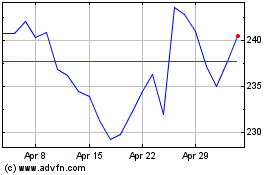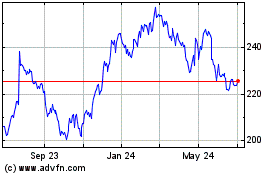By Paul Ziobro
Union Pacific Corp. never hired Hunter Harrison to run its
sprawling network. But with congestion clogging its system, the
company is now adopting the late railroad maverick's strategy to
speed its freight trains.
The railroad, which until recently had been adding locomotives
and crew, plans to use less equipment in a bid to improve its
financial performance and service.
"By a number of measures, it's evident that we have not made the
kind of progress in improving our service and productivity
performance in recent months," Union Pacific Chief Executive Lance
Fritz said Wednesday.
Union Pacific will shift its focus from moving trains to moving
the individual railcars, with the end goal of providing a tighter
delivery window for customers. It also will try to minimize
downtime for railcars, reduce the number of times cars are sorted
at facilities so-called hump yards and blend different types of
cargo on one train.
The strategy being implemented at Union Pacific was espoused by
Mr. Harrison, who was running rival CSX Corp. when he died last
December. He honed the so-called precision scheduled railroading
model over a five-decade career that included turning around two
large Canadian railroads before he took the helm of Jacksonville,
Fla.-based CSX last year.
During a nine-month stint at CSX where he battled undisclosed
health issues, Mr. Harrison quickly idled hundreds of locomotives,
eliminated thousands of jobs, closed facilities and overhauled
train schedules.
Mr. Harrison's plan was disruptive at each stop, resulting in
thousands of layoffs and jolting changes to railroad schedules that
led to complaints from shippers. But the strategy drastically cut
costs, resulted in faster train times and lifted stock prices.
Union Pacific executives hope the changes will ease congestion
that has lingered on the 32,000-mile railroad for nearly a
year.
As executives detailed the plan Wednesday, they said that they
haven't decided to close any rail yards yet and that specifics on
idling locomotives, laying off workers and other changes typically
associated with Mr. Harrison's strategy haven't been finalized. But
as the plan is rolled out with more precise train schedules, the
company expects costs to drop, and to avoid some of the service
hiccups of the past.
"There are periods when we have fantastic service product and
then periods where that fades," Mr. Fritz said.
The plan will start to unfold next month along the Union Pacific
corridor between Wisconsin and Texas, and be put in place across
the network by 2020.
Union Pacific has been working closely with customers to
communicate the changes, although the revamped operations may
result in some shippers being dropped. "There may be some customers
where we may have to decide that it does not fit in the network,"
said Kenny Rocker, Union Pacific's head of marketing and sales.
Executives have long said that Union Pacific would borrow ideas
from other railroads to improve its performance. In the lead-up to
the plan, the company has tested some precision-scheduled
railroading concepts on parts of its network. Some executives
recently adopted an informal name for weekly meetings aimed at
helping trains run more smoothly: "WWHHD," or "What would Hunter
Harrison do?," two people familiar with the matter said.
Union Pacific's service problems have stemmed from a number of
issues. New technology called positive train control that is meant
to prevent accidents has caused slowdowns, including inadvertent
stops, as it has been rolled out.
The strength in the economy has pushed additional volume onto
Union Pacific's rails, especially in the Southern region of a
network that spans the Western two-thirds of the U.S. Crew
shortages exacerbated the issues. Union Pacific has responded by
bringing locomotives out of storage, adding railcars to handle the
additional cargo and enticing new hires with bonuses of $25,000 or
more.
The network is still facing gridlock. In its second quarter,
Union Pacific's average train speed was 3% slower than a year
earlier, while average time spent at terminals rose 4%. The company
has spent tens of millions of dollars on extra equipment, labor
hours and fuel to unclog the network.
The problems have pushed up Union Pacific's operating ratio to
64% in the second quarter from 61.9% a year earlier. An operating
ratio represents the percentage of revenue consumed by operating
costs, so a decline is an improvement. Investors have demanded
more.
The Omaha, Neb.-based company has faced questions from analysts
as to whether it should follow CSX's strategy to operate with fewer
workers and equipment. It has already made changes, including a
shake-up of its management team last month that included the
retirement of its chief operating officer and the addition of a
chief strategy officer.
The company said the changes being implemented will help its
operating ratio hit 60% by 2020 and 55% longer-term.
Analysts wondered if Union Pacific would need outside help to
implement the changes, or if there is someone capable of
overhauling the company's operations and culture. "That's going to
be critical in order to implement this," Credit Suisse analyst
Allison Landry said.
The railroad isn't currently planning to tap outside help from
other railroads that have undergone a transformation. Mr. Fritz
said that while this is the first time Union Pacific is
implementing Mr. Harrison's principles on a large scale, "they are
not a mystery."
Write to Paul Ziobro at Paul.Ziobro@wsj.com
(END) Dow Jones Newswires
September 19, 2018 10:34 ET (14:34 GMT)
Copyright (c) 2018 Dow Jones & Company, Inc.
Union Pacific (NYSE:UNP)
Historical Stock Chart
From Mar 2024 to Apr 2024

Union Pacific (NYSE:UNP)
Historical Stock Chart
From Apr 2023 to Apr 2024
